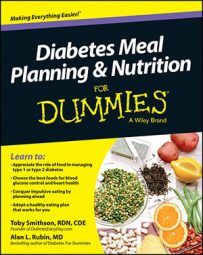There’s no doubt that you can visit a grocery and come home with a lot of food, but without a plan the outcome may be less than ideal. Your plan is your shopping list.
There are a few things you need to take along on your food shopping expeditions, but first things first — making time to go. Like it or not, managing your diabetes effectively can be inconvenient at times, and one category of inconveniences is making the effort to gather and prepare food at home. Once again, it’s a matter of perspective and priority.
If you don’t see the direct and intimate connection between what you eat every day and the potential impact of diabetes on your future health, then it’s only natural that you’ll find the other ways you can spend your time as more important than shopping.
If, on the other hand, you’re willing to accept that medical nutrition therapy — your diabetes meal plan — may help to add years of healthy living to your future, perhaps you’ll be less willing to trust this key component of your diabetes treatment to today’s special, free delivery, or food priced by the bucket.
If you accept the reality that food and your health are tied together, you clearly see the value in the time and effort you devote to planning your meals, and to gathering and preparing food yourself. Now, for a plan.
You wouldn’t dream of building a bookshelf, packing a suitcase, planting a tree, or jumping into just about anything else without some kind of forethought. If you have launched into a project or a trip with no plan, it’s likely the outcome was less than ideal.
Plans are the nuts and bolts of a vision, and the vision that inspires your shopping list is your menu — the breakfasts, lunches, dinners, and snacks that will help keep your blood glucose levels steady, work to manage your weight, and protect your cardiovascular system.
Having a specific menu is like knowing you want to build a bookshelf 4 feet tall, 4 feet wide, and 4 foot deep with three shelves. Making your shopping list is how you know you’ll bring home 28 feet of 12-inch-wide boards, 16 screws, and 12 shelf holders.
Here is key advice for making and using your shopping list:
Keep a running list so you can add replacement items as soon as you notice your supply is low.
Organize your list according to the general plan of the grocery. Even if you’re going to a store you’re not familiar with, the foods will still be generally grouped in the same way, even if not in the same place.
Make your list specific, and don’t get anything that isn’t on your list.
Ok, that last point may sound a little extreme, and it’s OK, of course, to grab something you actually need. But, planning your meals and making a specific list has a purpose beyond saving you trips. Making a plan and then sticking to the plan is an effective way to resist impulse.
You wouldn’t be likely to grab a 2-foot-long board for your bookshelf project, when you only need 4-foot boards, just because you like the way the 2-foot board looks. But, coming face to face with half-priced premium ice cream you don’t need can be a different story. Doing your thinking ahead of time by making a shopping list keeps food-related impulse buys from derailing your diabetes management success.

